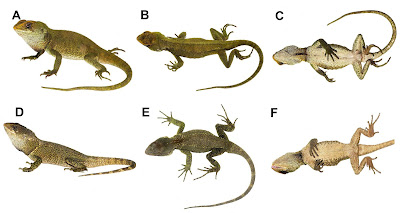 |
| Enyalioides cyanocephalus Enyalioides dickinsoni Venegas, García-Ayachi, Chávez-Arribasplata, Marchelie, Bullard, Quispe, Valencia, Odar & Torres-Carvajal, 2024 DOI: 10.25225/jvb.23074 |
Abstract
Based on morphological features, genetic distances, and phylogenetic relationships, we report the discovery of two new species of Enyalioides from the montane forest of Cordillera de Colán in northern Peru. The first new species can be distinguished from its congeners by the combination of the following characters: scales immediately posterior to superciliaries on lateral edge of skull conical, slightly higher than adjacent scales; gular scales heterogeneous in size; scales on neck mostly large and conical; dorsal scales between dorsolateral crests covered by large, keeled, mucronate scales; scales on flanks tiny, tuberculate or granular, with scattered enlarged conical or tuberculate scales; ventral scales keeled or feebly keeled; caudal scales heterogeneous, increasing in size posteriorly on each segment; and marked sexual dichromatism. Among other features, the second new species differs from other Enyalioides in having a distinctively low vertebral crest; scales immediately posterior to superciliaries on lateral edge of skull barely projected and similar in height to adjacent scales; 56-71 vertebral scales from occiput to base of tail; dorsal scales feebly keeled and heterogeneous in size; ventral scales keeled; and caudal scales heterogeneous, increasing in size posteriorly on each segment. In addition, we present an updated identification key for species of Hoplocercinae.
KEYWORDS: Andes, Enyalioides anisolepis, Huancabamba Depression, Lizards, River Marañón, Peruvian Yungas, systematics
Enyalioides cyanocephalus sp. nov.
Proposed common name in English: blue-headed wood lizards
Proposed common name in Spanish: lagartijas de palo de cabeza azul
Diagnosis: Enyalioides cyanocephalus can be distinguished from other species of Enyalioides, except its sister species E. anisolepis Torres-Carvajal, Venegas & de Queiroz, 2015 (Torres-Carvajal et al. 2023), by the combination of the following characters: 1) scales immediately posterior to superciliaries, on the lateral edge of skull, conical, slightly higher than adjacent scales; 2) gular scales heterogeneous in size; 3) scales on neck conical dorsally and conspicuously larger than the granular scales on the sides; 4) dorsal scales between dorsolateral crests covered by strongly carinate projected scales surrounded by tiny granular scales; 5) scales on flanks tiny, tuberculate or granular, with scattered enlarged conical or tuberculate scales; 6) ventral scales keeled or feebly keeled; 7) tail laterally compressed; 8) caudal scales heterogeneous, increasing in size posteriorly on each segment; 9) venter immaculate in adult males; and 10) marked sexual dichromatism with background dorsal colouration green in males (Fig. 1) and brown or greenish brown in females (Fig. 2).
Etymology: The specific epithet is derived from the Greek words ‘kyanos’, an adjective meaning blue, and ‘cephalus’, a noun meaning head. This specific name is used as a noun in apposition and refers to the bluish head of the holotype specimen. Although only two adult males in the type series possessed a distinctive bluish head, the males of this species are commonly known by the local people in Cordillera de Colán as blue-headed chameleon, which leads us to think that males of E. cyanocephalus with bluish heads are not uncommon.
Enyalioides dickinsoni sp. nov.
Proposed common name in English: Dickinson's wood lizards
Proposed common name in Spanish: lagartijas de palo de Dickinson
Diagnosis: Enyalioides dickinsoni can be distinguished from all known species of Enyalioides, except E. azulae, by the combination of the following characters: 1) a distinctively low vertebral crest, with the crest on neck at most twice as high as the crest between hind limbs; 2) scales immediately posterior to superciliaries on lateral edge of skull barely projected and similar in height to adjacent scales; 3) 56-71 vertebral scales from occiput to base of tail; 4) dorsal scales feebly keeled and heterogeneous in size; 5) ventral scales keeled; 6) tail circular in cross-section; and 7) caudal scales heterogeneous, increasing in size posteriorly on each segment.
Etymology: The specific name is a noun in the genitive form and is a patronym honouring Paul Bruce Dickinson (born 7 August 1958), who is best known as the lead singer of the legendary heavy metal band Iron Maiden, though he is also a music producer, entrepreneur, competitive fencer, novelist, aviator, broadcaster and the recipient of numerous honorary degrees and awards. In 2016, he flew a loggerhead sea turtle, Caretta caretta, that washed up on a Jersey beach to the Canary Islands in his private plane, thus contributing to the awareness and protection of this vulnerable species. We also highlight that Iron Maiden is a popular band among taxonomists and museum curators who appreciate rock music.
Pablo J. Venegas, Luis A. García-Ayachi, Juan C. Chávez-Arribasplata, Axel Marchelie, Santiago Bullard, Eduardo Quispe, Juan D. Valencia, Jasmín Odar and Omar Torres-Carvajal. 2024. Two New Species of Wood Lizards (Hoplocercinae: Enyalioides) from Cordillera de Colán in north-eastern Peru. J. of Vertebrate Biology, 73(23074); 1-17. DOI: 10.25225/jvb.23074
facebook.com/100064548225275/posts/798799382281662


